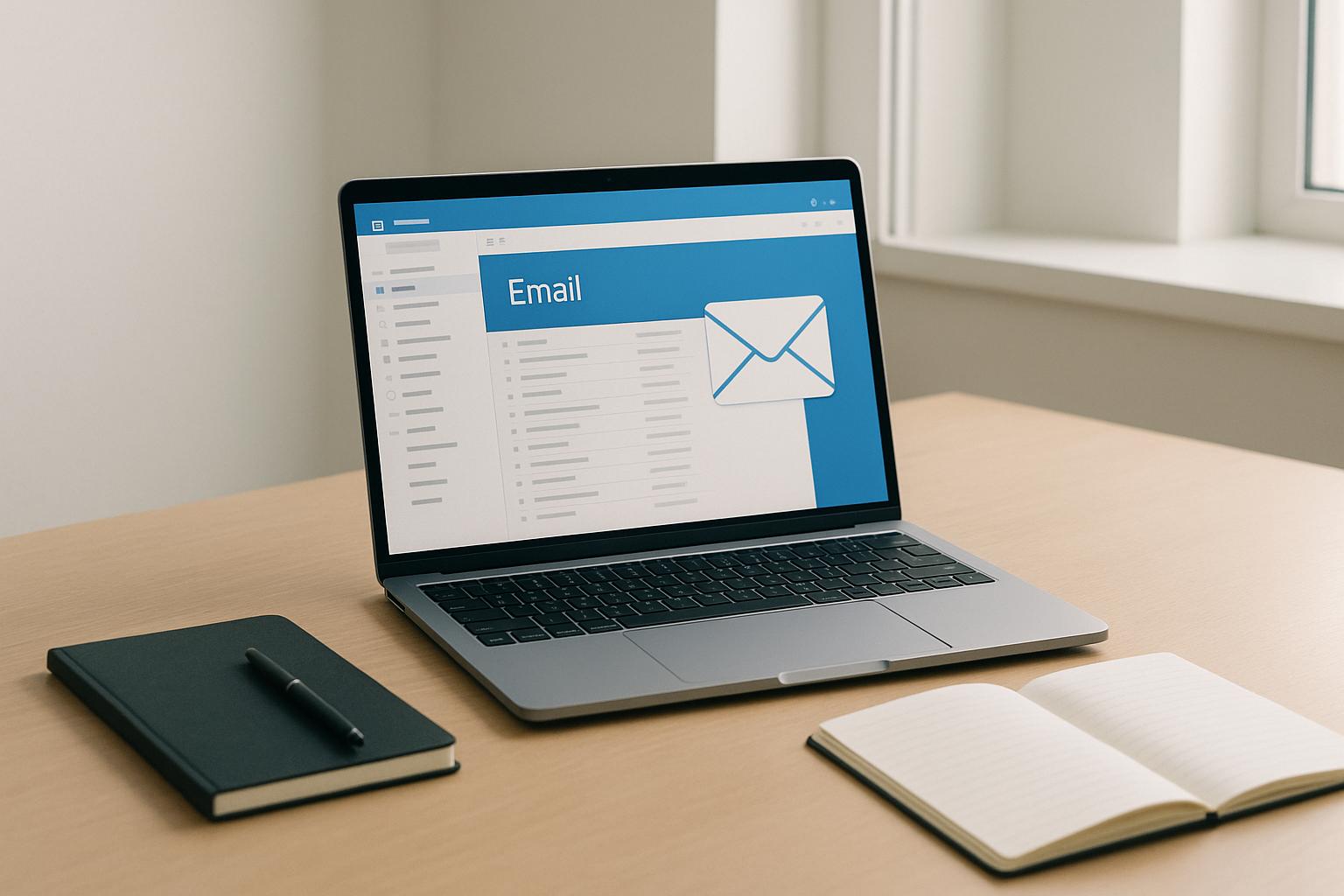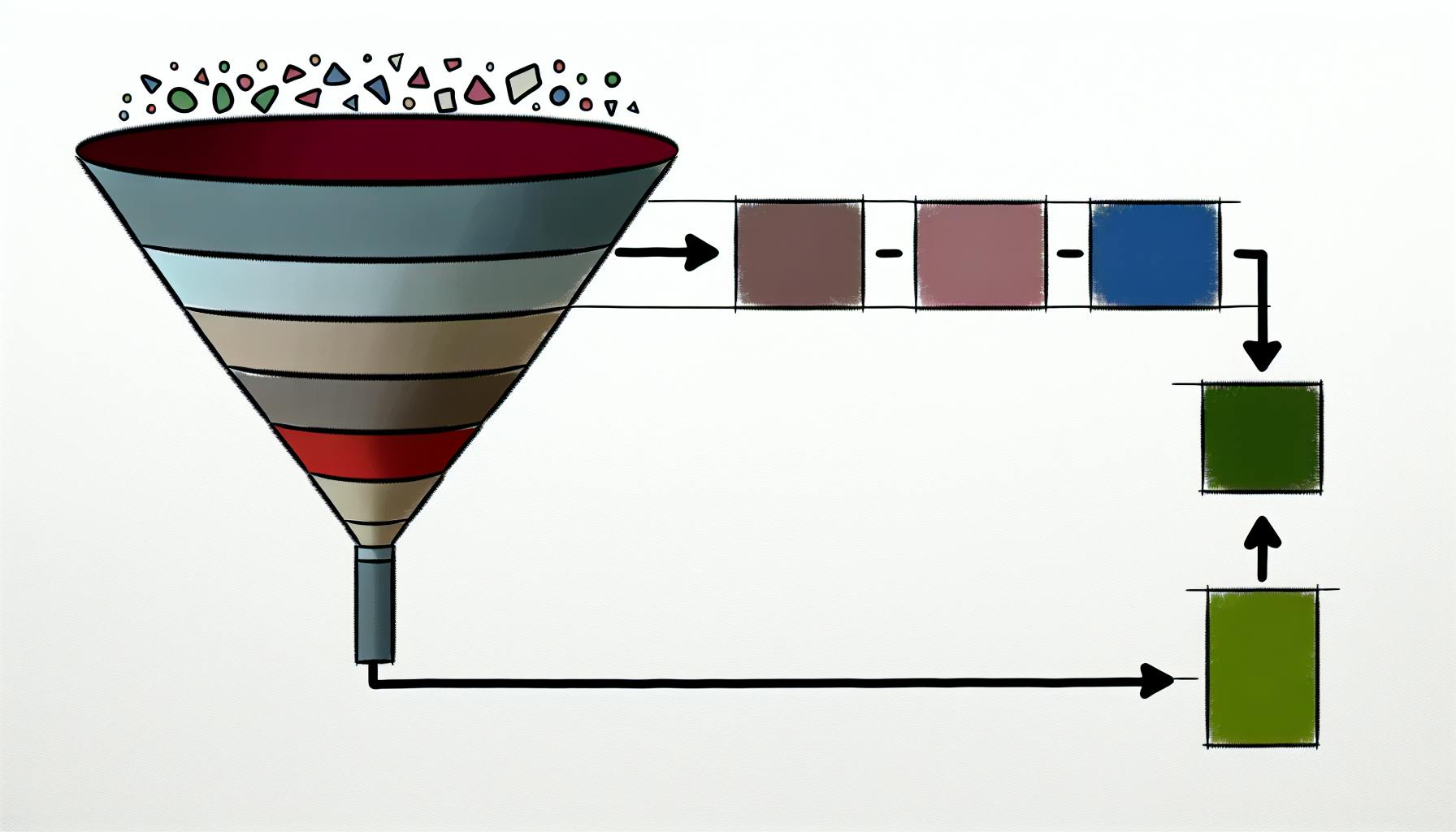Chatbots can help generate leads, but tracking the right metrics is key to improving performance and getting better results. Here’s a quick summary of the 10 most important metrics to monitor for chatbot success in lead generation:
- Active Conversations: Total interactions between users and the chatbot.
- Lead Conversion Rate: Percentage of interactions that turn into qualified leads.
- Response Speed: How quickly the chatbot replies to user queries.
- User Interaction Rate: Measures how much users engage with the chatbot.
- Lead Quality Score: Rates the quality of leads based on engagement and fit.
- User Satisfaction Score: Feedback from users on their chatbot experience.
- User Return Rate: Tracks how often users return to interact with the chatbot.
- Task Completion Rate: Percentage of users successfully completing desired actions.
- Live Agent Transfer Rate: Percentage of conversations escalated to a human agent.
- Lead Acquisition Cost (LAC): Cost per qualified lead generated by the chatbot.
Why It Matters:
- Lower Costs: Metrics like LAC help optimize spending.
- Better Performance: Response speed and satisfaction scores highlight areas to improve.
- Higher-Quality Leads: Metrics like Lead Quality Score ensure you're targeting the right users.
Actionable Tip: Start by focusing on conversion rate, task completion, and response speed to see immediate improvements in your chatbot's lead generation performance.
Talking the Talk: Measuring Chatbot Accuracy
1. Number of Active Conversations
The number of active conversations represents all interactions between your chatbot and potential leads. It’s a key metric for gauging engagement levels and understanding how well your chatbot is performing in generating interest. After this, it’s important to analyze the conversion rate to see how many of these interactions successfully turn into leads.
2. Lead Conversion Rate
Lead conversion rate shows how well your chatbot turns interactions into qualified leads. It’s a key metric for assessing how effectively your chatbot identifies potential customers. Most chatbots see conversion rates between 3–5%, while the best performers can hit 10%. To calculate it, divide the number of qualifying conversations by the total interactions, then multiply by 100.
What Affects Lead Conversion?
Several factors can influence how many leads your chatbot generates:
- Dialogue Flow: Design conversations to naturally guide users toward key actions while collecting the information needed to qualify them.
- Timing of Lead Forms: Offer lead capture forms after addressing user needs or answering major questions.
- Qualification Criteria: Clearly define what makes a lead "qualified" to ensure accurate tracking.
Factors to Evaluate Conversions
When assessing your conversion rates, consider the following:
| Factor | Weight | Impact on Conversion |
|---|---|---|
| Budget Range | High | Helps identify qualified leads directly |
| Timeline | Medium | Indicates urgency |
| Decision Authority | High | Shows readiness to buy |
| Company Size | Medium | Aligns resources |
Tips to Improve Lead Conversion
Want better results? Focus on these strategies:
- Highlight Benefits: Clearly explain the value your product or service offers.
- Simplify Forms: Only ask for the most important details.
- Use Progressive Profiling: Collect user data gradually over multiple interactions.
- Strategic Call-to-Actions (CTAs): Place CTAs where users are most likely to make a decision.
3. Average Response Speed
Fast response times are a game changer. Quick replies help keep users engaged and boost conversions.
Key Response Time Metrics
Here are some key areas to focus on when evaluating chatbot response speed:
| Response Type | Best Practice | Impact on Lead Generation |
|---|---|---|
| Initial Greeting | Instant response | Leaves a positive first impression |
| Simple Questions | Quick reply | Keeps users engaged |
| Complex Queries | Timely and detailed reply | Shows the bot’s ability to handle depth |
| Handoff to Agent | Minimal wait time | Prevents user frustration and drop-off |
Ways to Improve Response Times
Boost your chatbot's speed with these simple tactics:
- Cache Responses: Save answers to common questions locally for instant replies.
- Progressive Loading: Use typing indicators to show the bot is processing a query.
- Intent Recognition: Pre-process frequently asked questions to reduce response delays.
How It Impacts Lead Quality
Fast responses don’t just keep conversations flowing - they also improve lead quality. Users are more likely to stay engaged, enjoy smoother interactions, and leave with a better overall experience.
Technical Factors to Watch
Pay attention to server load, third-party API performance, and database query speed. Striking the right balance between NLP accuracy and response time is also critical. Finally, analyze user interactions to find more ways to refine lead generation.
4. User Interaction Rate
User interaction rate shows how much visitors engage with your chatbot, giving insight into how well it sparks interest and steers conversations toward generating leads.
To measure this, track the number and quality of message exchanges. Also, monitor how often users interact with features like buttons, menus, or other elements designed to guide them toward specific actions. This data helps you fine-tune your chatbot's flow for smoother conversations.
Boost engagement by creating natural, context-aware conversation paths. Avoid repetitive questions and aim to keep users engaged, reducing the chances they leave mid-conversation.
Once you've made adjustments, study how users interact to further improve the chatbot's design and make it even better at generating leads.
5. Lead Quality Score
After looking at conversational metrics, it's time to assess lead quality. This step helps you figure out how well your chatbot identifies potential customers who are a good fit.
Key Scoring Factors:
- Engagement Level: Measure time spent, questions answered, depth of responses, and any follow-up actions taken.
- Budget and Timeline: Evaluate leads based on their stated budget, purchase timeline, and decision-making authority.
- Demographic and Firmographic Fit: Check how well the lead aligns with your ideal customer profile, including company size, industry, location, and role.
Scoring Framework:
Use this table to assign points to leads based on specific criteria:
| Criteria | Points | Description |
|---|---|---|
| Budget Match | 0-30 | Fits minimum budget requirements |
| Timeline | 0-25 | Ready to buy within 3 months |
| Authority | 0-20 | Has decision-making power |
| Engagement | 0-15 | Shows strong interest through interactions |
| Profile Match | 0-10 | Matches your ideal customer profile |
Lead Categories:
- 80-100 Points: Hot leads - follow up immediately.
- 60-79 Points: Warm leads - prioritize nurturing these.
- Below 60 Points: Cold leads - automate nurturing efforts.
sbb-itb-8aac02d
6. User Satisfaction Score
After evaluating lead quality, it's crucial to assess user satisfaction, as it offers a clear view of how well your chatbot is performing. This metric helps pinpoint areas where engagement might be lacking or where qualification processes could improve.
To gather this feedback, ask users to rate their experience or answer follow-up questions at the end of each conversation. Regularly analyzing these satisfaction scores helps fine-tune your chatbot's performance and improve its ability to generate leads effectively.
7. User Return Rate
User return rate is the percentage of users who come back to interact with your chatbot. This metric shows how engaging and useful those interactions are. A higher return rate suggests that users see value in their conversations with the chatbot.
To improve this, create conversations that encourage repeat engagement. Fine-tuning your chatbot's responses and dialogue can make interactions more meaningful, which also helps with lead generation. Keep an eye on this metric along with others to better understand how your chatbot is performing in driving leads.
8. Task Completion Rate
Task completion rate shows how well your chatbot helps users complete specific actions, such as filling out a form, scheduling a demo, or downloading a resource. This metric directly reflects how effectively your chatbot guides users toward their goals. For example, if 750 out of 1,000 conversations result in completed tasks, your task completion rate is 75%.
This metric is crucial because it helps you:
- Align with Goals: Measure how different conversion paths perform and identify the most effective ones.
- Spot Drop-Offs: Find out where users abandon the conversation.
- Focus Improvements: Identify dialogue flows that need adjustments.
To improve task completion rates:
- Simplify conversation flows.
- Reduce the number of steps needed to complete an action.
- Include clear calls-to-action throughout.
- Offer helpful prompts when users seem stuck.
- Experiment with different conversation paths to see what works.
Keep an eye on this metric alongside your lead conversion rate to understand your chatbot's overall performance. If your task completion rate is under 50%, it's a clear sign to revisit your chatbot's design and user experience. Up next, we'll explore more metrics to fine-tune chatbot performance.
9. Live Agent Transfer Rate
After reviewing task completion data, it's important to track the live agent transfer rate to maintain a good balance between automation and human support.
This metric shows the percentage of chatbot interactions that need to be handed off to a human agent. It helps gauge how well your chatbot manages lead generation independently and pinpoints situations where human assistance is necessary.
The ideal transfer rate varies depending on your business model. A high transfer rate might mean your chatbot struggles with complex questions, while a very low rate could indicate missed chances for personalized interaction.
Here’s the formula to calculate it:
Live Agent Transfer Rate = (Number of Conversations Transferred / Total Conversations) × 100
For instance, if 200 out of 1,000 conversations are transferred, the transfer rate is 20%. Tracking this metric can help you:
- Evaluate automation performance: See how well your chatbot manages inquiries without help.
- Spot knowledge gaps: Identify recurring topics that lead to transfers.
- Plan resources effectively: Adjust customer service staffing based on transfer patterns.
- Balance costs and service quality: Find the right mix of automation and human involvement.
Tips to Improve Live Agent Transfers
-
Examine Transfer Triggers
Review conversations that needed human intervention to uncover areas for improvement. -
Use Smart Routing
Set up intelligent transfer rules based on factors like conversation complexity, lead qualification, customer value, or urgency. -
Expand Chatbot Knowledge
Regularly update your chatbot’s responses using insights from frequently asked questions, common issues, seasonal trends, and updates to your products or services.
10. Lead Acquisition Cost
Lead Acquisition Cost (LAC) calculates how much you spend to gain each qualified lead through your chatbot. Here's the formula:
LAC = (Total Chatbot Costs / Number of Qualified Leads Generated)
What counts as total chatbot costs?
These include both direct and indirect expenses, such as:
- Setup and implementation fees
- Monthly subscription or licensing costs
- Maintenance and updates
- System integrations
- Training and optimization efforts
To find your LAC, divide the total monthly costs by the number of qualified leads your chatbot generates.
Tips to Improve Your LAC
- Focus on improving conversation quality to reduce wasted interactions.
- Simplify conversation flows to avoid drop-offs.
- Use automation for lead scoring and qualification to save time and resources.
Keep an eye on related metrics like conversion rates, response times, and engagement levels. These will give you a better understanding of your chatbot's performance and help you make smarter decisions for improvement.
Conclusion
Keeping track of chatbot metrics is crucial for generating leads effectively. It allows you to make informed decisions, improve performance, and maximize your return on investment (ROI).
Here’s how regular tracking can make a difference:
- Lower Costs: By analyzing metrics like Lead Acquisition Cost, you can allocate resources more efficiently.
- Improved Performance: Reviewing response times and user satisfaction scores helps identify areas for improvement.
- Higher-Quality Leads: Monitoring metrics such as Lead Quality Score and Task Completion Rate helps refine your qualification process, increasing the value of your leads.
Regular monitoring is key to driving long-term success.


